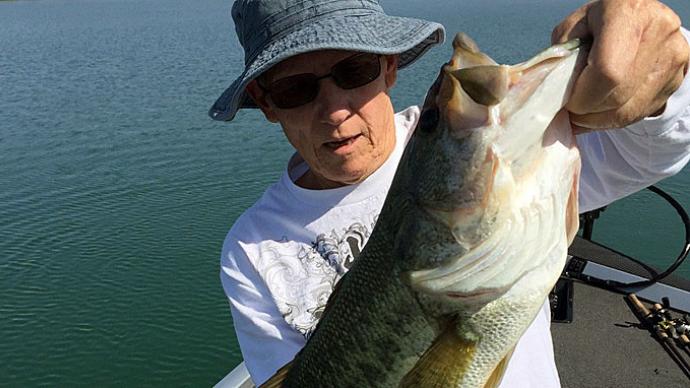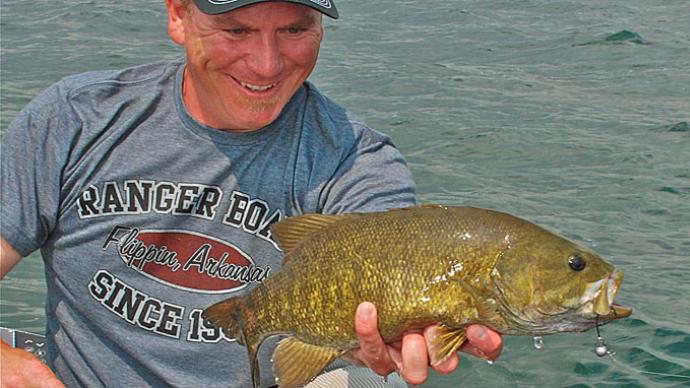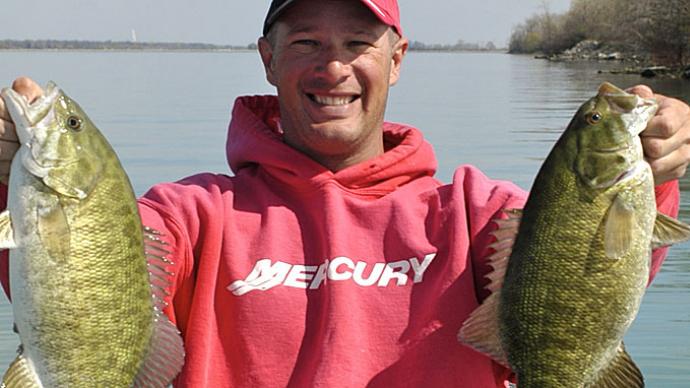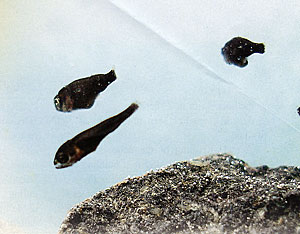
That dark underwater cloud moving in unison looks like a school of black tadpoles swimming in a cluster in your pond. Maybe they are some sort of bugs, or maybe even fish. Since it was spring and since you have Smallmouth bass in your pond, expect they are smallmouth bass fry. Let's investigate and take a closer look to see what happened for tiny eggs to become a group of free swimming baby bass.
Maturing Bass
Smallies mature more quickly in warmer southern waters than north of the Mason-Dixon Line. In northern waters, expect maturity at 2-4 years for males and 3-4 years for females. In southern waters, smallmouth bass mature at 1-2 years of age. Population density, length of growing season, average water temperature, abundance of food and water quality affect growth rates. Males and females tend to grow at similar rates. Numerous studies have shown that as older fish die, or are harvested from the pond or lake, smallies can have difficulty with recruitment. I see this occur most frequently in ponds where smallies are coexisting with largemouth bass.
Consistent and dependable production of fingerling smallmouth compared to largemouth bass has been a challenge, even for some hatcheries. It is common for as many as 50% of all nests to fail. In some years, all nests fail and produce no fry. When hatchery ponds for fingerling smallmouth are drained, growers often find disappointing low numbers of fingerlings. Since the 1930's, numerous studies have been made to figure out the best ways to increase the numbers of young bass.
Figure out how to favorably stack the reproductive deck for your smallmouth.
The first stages of the spawning process occur each spring when waters reach stable temperatures of 55-65F. The male builds the nest primarily in the mornings over a period of 4 to 48 hours. In calmer waters, he often orients himself vertically in the water and uses his tail to sweep the area clean of loose sediments. He uses his nose to push rocks around in the depression, forming a crater-like nest. Sometimes males have been seen relocating larger rocks and objects with their snout and mouth. The nest diameter is often twice the length of the male. The best nests have been described as large, perfectly circular, clean gravel depressions. (Becker 1983).
Not all males make nests each year. Often only about 25% of mature males make nests in any given year. Largest males are usually first to build nests and regularly have the most successful nests which produce the most fry.
Smallmouth females generally do not produce as many eggs per nest compared to largemouth bass and this helps explain why it is important to start with some good basic structural features to improve the hatch.
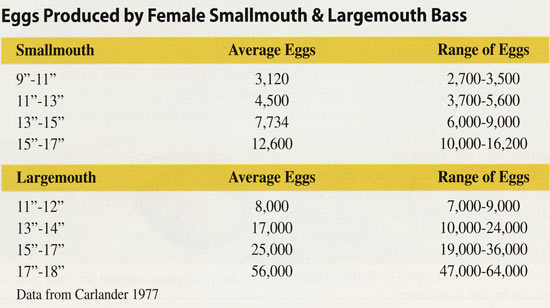
Egg Laying
Eggs don't mature in the female smallie all at once. Consequently, she may spawn two or three times before being spent. Females, heavy with eggs, have negative buoyancy and sometimes swim in a "heads up" position. this awkward swim has been referred to as "tail walking".
Actual spawning of the male and female typically occurs right after nest building but it may be delayed for several days as the water reaches temperatures around 61-65 degrees F.
Courtship behavior is unique to smallies, which is one of the several reasons smallies do not readily hybridize with largemouths (Becker 1983).
The female usually releases 20-50 eggs in periods of 4-10 seconds as the male fertilizes them. Sessions are often separated by periods of 30 seconds. A female might remain, laying eggs with the male, for up to two hours. Males often spawn with more than one female during a 36 hour period. The number of eggs per nest typically ranges from 2,000 to sometimes 16,000. Large 20" female smallies have been estimated to have as many as 27,000 eggs.
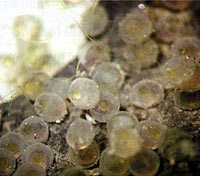
Water hardened eggs are semi-transparent, with grayish white to light amber yolks and about 3/32" (1.8-2.8mm) in diameter. Egg color is dependent on the habitat where bass live. At first, eggs are sticky, binding to each other and to anything in the nest. Soon, they lose their adhesiveness and, if among larger stones, will settle lower into the nest which provides protection from nest raiders.
Preferred nest material of coarse gravel with numerous small nooks and crannies helps protect more eggs, yet allows adequate water circulation that delivers necessary dissolved oxygen to developing embryos. Before eggs hatch, many laid on hard surfaces, sandy bottoms or small gravel can be lost to predators.
Other problems for eggs they develop are siltation, fungus, or rapidly decreasing water temperatures. Water temperatures below 60F, after egg laying, lengthen hatching time and increase chances for eggs to develop fun-us infections and die. Low water temperatures during egg development increase chances of deformity, stunting, or modified behavior patterns of fry that leads to eggs and fry being more vulnerable to starvation or predation.
Developing Eggs
After egg laying, the male stays at the nest and protects the eggs by circulating water throughout the nest. Larger males tend to be more protective and aggressive in defense of the nest than smaller males.
In scientific literature, there's conflicting information regarding the benefit to eggs from water circulation due to male activity versus natural water movement and quality. Researchers have removed the male immediately after spawning in a hatchery pond. Nests were isolated with a wire cage to exclude predators and still allowed natural water movement around the eggs. Good hatches were observed from these test nests. Researchers concluded the main function of the male was to protect the eggs and keep them free of sediment and not necessarily aerate them. I suspect that the more turbid a pond, the more important that water circulation from the male's guarding and circular swimming activities becomes as a benefit of keeping settling sediment and detritus from collecting on the eggs and suffocating the embryos.
If eggs or fry lie exposed on the bottom among small sand or fine gravel then they are more vulnerable to being eaten by nest predators. Some nests will lose all eggs to predators. If the male has to only defend the nest from two or three sides, then protection is more successful. This is why a large rock or bulky structure with a half log, or a cover log, are important items to have near the nest.
Whenever the male bass leaves the nest, unattended exposed eggs are quickly eaten by predators. Many small fish such as minnows, perch, bluegill, fingerling bass and even crayfish or large insects prey heavily on eggs or fry when the parental male is distracted or chasing away other nest invaders. Large fry from the first smallie spawn have been seen feeding on new fry from the second nesting or from other fish's nests.
Angling and removing the male from a nest even temporarily in a pond can result in large losses of eggs or fry to the hungry mouths of small predators. It has been estimated that 100 eggs or fry can be consumed during each invasion of small nest raiders. Also, studies have shown that catch-and-release during the guarding stage can cause premature nest abandonment by the male smallie (Suski et al 2003). The largest male bass produce the largest broods and are the most defensive and most likely to be caught by anglers. It is believed that captured and released bass are less able and less willing to protect their brood, especially after exhaustive exercise of fighting the business end of a rod and reel. One study found that displacement of males by angling resulted in empty nests the following day. Angling for bass during spawning season is not beneficial for producing smallie fry.
The Hatch
Eggs typically hatch in 60 hours to 4-6 days depending on water temperatures that typically range from 60-77F. Newly hatched fry are nearly transparent and slightly less than 1/4" (5mm) long. The head is curved down over the yolk sac. At this stage the fry are technically called yolk-sac larvae. Many species of freshwater fish have this same general shape as newly hatched fry.

New yolk sac fry have no fins. They have a fin fold that is a median. thin, clear membrane that extends from behind the head around the "tail" (urostyle, straight pointed end of the spine) and to the back of the yolk. All the median fins of the dorsal, tail, and anal fins eventually develop from this fin fold.
Newly hatched yolk-sac fry are mostly inactive an lie somewhat protected, hopefully in the cracks and large voids among the nest materials.
As growth occurs, the body straightens and the mouth cavity forms when the fry is about 6mm long. At 7mm, the mouth opens, the lower jaw forms and the heart chamber becomes visible. The yolk and oil droplet are the fry's food source until the fry are about 10mm (1/2") long.
The first fins to develop from tiny buds on the side behind the head are the pectoral fins. Over the first 4-7 days, yolk-sac fry (5-7mm) gradually become more active swimmers due to relatively large, rudimentary, rayless, developing pectoral fins. These fins allow weak, intermittent swimming movements and at about 7-8mm, fry move to the surface of the nest. (Neves 1975)

Fry become more active as body pigments darken at size of 8-9mm. At this size of the soft dorsal and anal fins start to develop and the first rays of the caudal fin start to show.
Late stage fry are darkly pigmented and appear as "black fry" for the first 10-20 days. The bottom of the nest now contains dark blotches or blackened areas which are clusters of fry. Black coloration makes the fry easy to see in clear water and thus even more vulnerable to predation.
Swim Up Fry
The oil droplet is the last self-contained food reserve absorbed as yolk fry become more active. When the oil droplet is consumed, the yolk-sac stage ends. If all eggs were laid at about the same time in one spawn session, most of fry will develop at the same rate.
|
Image
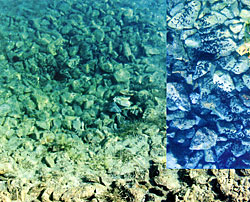
Image
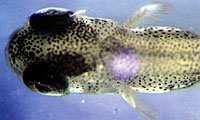
|
Gradually, more and more fry begin short and more frequent vertical swimming movements. Over several hours most all surviving fry are rising or swimming up from the next as a loose group. If spawning occurred during more than a few hours, fry swim up sporadically over a long period of time.
Often, it is 8-11 days after hatch when fry leave the nest. Fry now range in length from 8-10mm long. When they reach this free swimming stage and all the yolk and oil drop are absorbed, fish nerds now call them "post larvae". I will continue to call them fry for the rest of the article. Swim up fry are still darkly pigmented and hang out in shallow water where they appear as a group of black specks moving in water. This is where the term "black bass" originated.
As fry rise from the nest as a loose school, the male herds them and attempts to continue to protect them. Some type of overhead structure on or near the nest is helpful for vulnerable, slow and weakly swimming fry to survive predation when they first swim up. Males tend to herd the fry and keep them from leaving the nest site. The male parent cannot defend the fry from mass intrusions at this point.
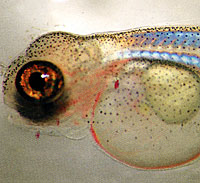
Mortality of dark colored fry can be very high during the first few hours and days after they leave the nest. Smallie fry have fewer tendencies to remain in a tight school compared to largemouth fry. Thus, a male smallie has a harder time trying to guard and protect all the fry.
As fry disperse from the nest and later the school, adjacent cover is beneficial. Areas such as submerged rooted vegetation, brush, and logs to help provide refuge and help them escape numerous predators. Habitats with crevices from large rocks and boulders and large woody debris are used more frequently and considered better refuge areas for young smallies than weed beds, and bottoms composed of much, silt, gravel, or cobble (Sabo, M.J. and D.J. Orth 1994).
In laboratory experiments, predation of fry was higher in vegetation compared to habitat dominated by cobble-sized rocks.

A few fry will be forced from the school and seek refuge around structure near the brood site.
This is another reason why the half log structure at or near the nest is considered beneficial.
Reports of how long a ale smallie attempts to protect fry vary from 24 hours to several days. My experience is larger bass and predators initially tend to ignore tiny fry. Fry are too small for the larger fish to eat. Abundant small panfish primarily predate most heavily on bass fry.
Over the next 7 to 9 days (12-120 days post hatch), fry grow from 11 to 16mm long. Their color gradually changes from black to light brown or green. During this period, heads and mouths enlarge, a full complement of fins develops, and their body shape changes into a more bass-like profile. Their fins are now more developed and they become much better swimmers. They soon learn to be wiser and quicker at avoiding bigger things that base them.
As the school ages, fry gradually break into smaller groups and the male quits his guarding tasks. As fry grow from 5/8" to 1" (12-25mm) long, they are now much more aware of their surroundings and incoming predators send them scurrying for some form of cover.
Fry Foods

Fry, as small as 8mm long, begin feeding on external foods when swimming up from the nest. Main feeding occurs as fry absorb the last of the oil droplet. First foods include zooplankton-rotifers and various types of water fleas (copepods and cladocerans). Older fry gradually roam further and further from the nest as they begin feeding in shallow water by searching and feeding on groups of tiny plankton critters and tiny bugs associated living on or near the bottom. Other first foods are newly hatched early instars of midge and mayfly larvae. When fry are 12-13mm long, their mouth is big enough to swallow newly hatched minnow and sunfish fry (see photo). A 12mm fry was found to have eaten another smaller fry. When I raised smallie fry for these photographs, they, at 11-12mm long, would eat 1-5 day old shiner fry.
Reprinted with permission from Pond Boss Magazine

